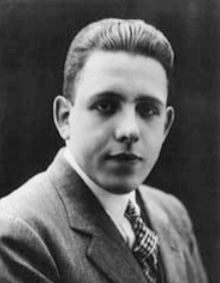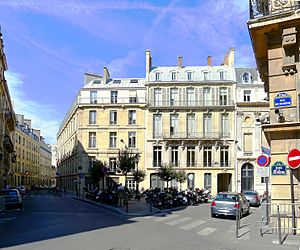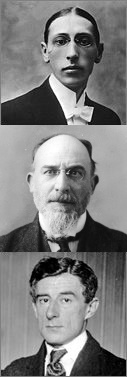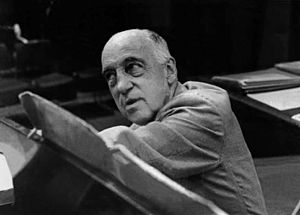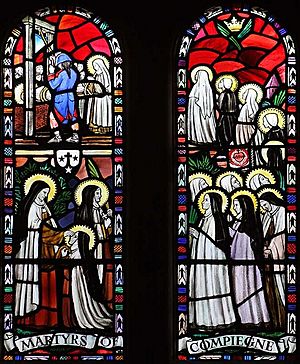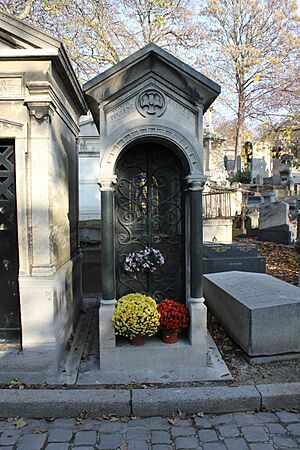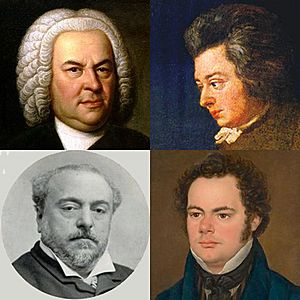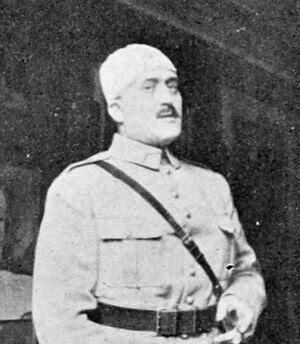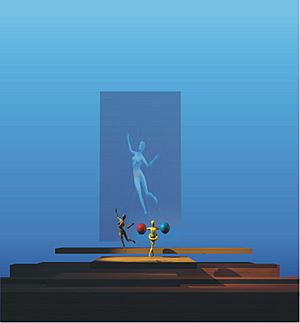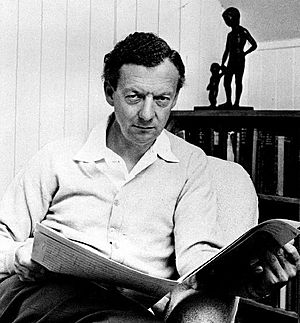Francis Poulenc facts for kids
Francis Jean Marcel Poulenc (born January 7, 1899 – died January 30, 1963) was a famous French composer and pianist. He wrote many different kinds of music. These included songs, piano pieces, chamber music (for small groups of instruments), choral works, operas, and ballets.
Some of his most well-known pieces are the piano suite Trois mouvements perpétuels (1919) and the ballet Les biches (1923). He also composed the Concert champêtre (1928) for harpsichord and orchestra, and the Organ Concerto (1938). Later, he wrote the opera Dialogues des Carmélites (1957) and the Gloria (1959) for singer, choir, and orchestra.
Poulenc was the only son of a rich businessman. His family expected him to join their company. Because of this, he was not allowed to study music at a special college. Instead, he learned from the pianist Ricardo Viñes. Viñes became his guide after Poulenc's parents passed away. Poulenc also met Erik Satie, another composer. Satie helped him become part of a group of young composers called Les Six.
At first, Poulenc's music was known for being lively and fun. But in the 1930s, he started writing more serious music. This included religious pieces from 1936 onwards. He often mixed these serious works with his lighter, more cheerful ones.
Besides composing, Poulenc was a skilled pianist. He was especially known for performing with the singer Pierre Bernac and the soprano Denise Duval. He toured Europe and America with them. He also made many recordings as a pianist. Poulenc was one of the first composers to understand how important the gramophone (an early record player) would become. He started recording his music in 1928.
For many years, especially in France, Poulenc was seen as a funny, light-hearted composer. His serious religious music was often overlooked. However, in the 21st century, people have paid more attention to his serious works. His operas Dialogues des Carmélites and La voix humaine are now performed more often around the world. His songs and choral music are also frequently performed and recorded.
Contents
Poulenc's Early Life
Francis Poulenc was born in Paris, France. He was the younger child and only son of Émile and Jenny Poulenc. His father, Émile, co-owned Poulenc Frères, a successful company that made medicines. His father's family was very religious and Roman Catholic. His mother, Jenny, came from a Parisian family who loved art.
Poulenc believed that his two different sides came from his parents. His deep religious faith came from his father's family. His artistic and worldly side came from his mother's family. A critic named Claude Rostand once said Poulenc was "half monk and half naughty boy."
Poulenc grew up in a home filled with music. His mother was a good pianist. She played many different types of music, from classical to more popular tunes. This gave him a lifelong love for what he called "adorable bad music." He started piano lessons when he was five. When he was eight, he first heard music by Debussy. He was amazed by its unique sound. Other composers who influenced him were Schubert and Stravinsky. Their works made a big impression on him. His father wanted him to have a normal school life. So, Poulenc studied at the Lycée Condorcet in Paris instead of a music school.
In 1916, a childhood friend introduced Poulenc to a bookshop. There, he met famous poets like Guillaume Apollinaire and Paul Éluard. He later used many of their poems in his songs. In the same year, he became a student of the pianist Ricardo Viñes. Viñes greatly influenced Poulenc's piano playing and his keyboard music style.
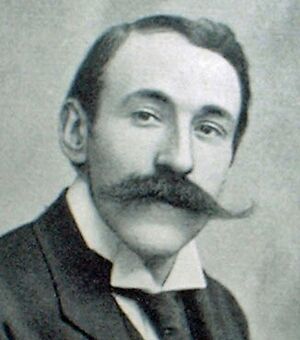
Poulenc's mother died when he was sixteen. His father died two years later. Viñes became more than just a teacher; he became Poulenc's "spiritual mentor." He encouraged Poulenc to compose. Viñes later performed the first public showings of three of Poulenc's early works. Through Viñes, Poulenc became friends with two composers who shaped his early style: Georges Auric and Erik Satie.
Auric was the same age as Poulenc. He was musically advanced for his age. By the time they met, Auric's music had already been played in important Paris concerts. The two young composers shared similar musical ideas. Auric remained Poulenc's most trusted friend. Poulenc called him "my true brother in spirit." Satie was an unusual figure, separate from the main French music scene. He guided several young composers, including Auric. Satie first thought Poulenc was just a rich amateur. But he later accepted him into his group of students. Poulenc said Satie's influence on him was "immediate and wide."
First Compositions and "Les Six"
Poulenc first showed his music to the public in 1917. This was with his Rapsodie nègre. It was a five-part piece for a baritone singer and a small group of instruments. He dedicated it to Satie. It was first performed at a concert series for new music. At that time, African art was popular in Paris. Poulenc found some published poems that seemed to be from Liberia. He used one of these poems in two parts of his piece. The singer hired for the first performance got nervous. Poulenc, who wasn't a singer, stepped in and performed it himself. This playful act was the first of many examples of his fun and quirky style.
The famous composer Ravel found the piece amusing. Stravinsky was impressed enough to help Poulenc get a contract with a music publisher. Poulenc never forgot this kindness.
From 1918 to 1921, Poulenc served in the French army during and after World War I. His duties allowed him time to compose. He wrote the Trois mouvements perpétuels for piano and a Sonata for Piano Duet. He also finished his first group of songs, Le bestiaire. The sonata didn't make a big impression. But the song cycle made his name known in France. The Trois mouvements perpétuels quickly became popular around the world. Being in the army taught Poulenc to write music for whatever instruments were available.
At this time, Poulenc knew he lacked formal music training. Satie didn't like music colleges. But Ravel told Poulenc to take composition lessons. Another composer, Milhaud, suggested Charles Koechlin. Poulenc studied with Koechlin from 1921 to 1925.
Four of Poulenc's early works were first performed at the Salle Huyghens in Paris. Between 1917 and 1920, concerts there featured music by young composers. These included Auric, Honegger, Darius Milhaud, and Germaine Tailleferre. These composers, along with Poulenc and Louis Durey, became known as "Les Six". After one of their concerts, a critic wrote an article titled, "The Five Russians, the Six Frenchmen and Satie."
The writer Jean Cocteau was like a father figure to the group. His writing style was anti-romantic, short, and playful. Poulenc loved it. He first set Cocteau's words to music in 1919 and his last in 1961. When members of Les Six worked together, they each wrote their own parts. Their 1920 piano suite, L'Album des Six, has six separate pieces. Their 1921 ballet, Les mariés de la tour Eiffel, included parts by Milhaud, Auric, Poulenc, and Tailleferre.
Growing Fame in the 1920s
From the early 1920s, Poulenc became well-known outside France, especially in Britain. He was popular both as a performer and a composer. In 1921, a critic wrote that Poulenc "ought to develop into a farceur of the first order." The critic said he had rarely heard anything as wonderfully silly as parts of Poulenc's song cycle Cocardes.
In 1922, Poulenc and Milhaud visited Vienna. They met composers like Alban Berg and Arnold Schönberg. The French composers were not influenced by their Austrian colleagues' new twelve-tone system. But they admired them greatly.
The next year, Poulenc received a request from Sergei Diaghilev to write a full ballet. He decided the ballet would be a modern version of a classical French party scene. This work, Les biches, was an instant hit. It premiered in Monte Carlo in 1924 and then in Paris. It remains one of Poulenc's most famous pieces.
As the 1920s continued, Poulenc wrote many different pieces. These included songs, chamber music, and another ballet, Aubade. The singer Pierre Bernac first sang Poulenc's songs in 1926. Bernac and Poulenc would become very close collaborators. Another performer Poulenc worked closely with was the harpsichordist Wanda Landowska. Poulenc heard her play in a modern piece and loved the sound. At Landowska's request, he wrote a concerto for her, the Concert champêtre. She performed it for the first time in 1929.
Poulenc bought a large country house in Noizay, about 140 miles southwest of Paris. He went there to compose in peace. He was very happy and successful at this time. However, he also experienced his first period of sadness, which affected his ability to compose. He was very upset when his friend Raymonde Linossier died suddenly in 1930. He wrote, "All my youth departs with her... I am now twenty years older."
New Seriousness in the 1930s
At the start of the 1930s, Poulenc began writing songs again. His song "Epitaphe" was written in memory of Linossier. It is described as a very deep song. The next year, Poulenc wrote three sets of songs. Some were serious, while others were light-hearted, like his earlier works. In 1932, his music was among the first to be broadcast on television by the BBC.
Two events in 1936 led Poulenc to a deeper religious faith and a new seriousness in his music. His fellow composer Pierre-Octave Ferroud died in a car crash. Almost immediately after, while on holiday, Poulenc visited the holy place of Rocamadour. This experience deeply moved him.
Other works that followed showed Poulenc's new seriousness. These included many settings of poems by Éluard. In 1937, he wrote his first major religious work, the Mass in G major. This piece has become one of his most performed sacred works. However, not all of Poulenc's new compositions were serious. His music for the play La Reine Margot was light and playful. It became popular as the Suite française. Music critics often continued to see Poulenc only for his light-hearted works. It wasn't until the 1950s that his serious side was widely recognized.
In 1936, Poulenc started giving many concerts with Bernac. They performed Poulenc's Cinq poèmes de Paul Éluard for the first time in Paris. They continued to perform together for over twenty years. Poulenc wrote 90 songs for Bernac. He considered Bernac one of the "three great meetings" of his career. Bernac was Poulenc's advisor, helping him with his songs, operas, and choral music.
Poulenc was popular with British audiences throughout the 1930s. He worked well with the BBC in London, which broadcast many of his works. His music was also popular in America. It was seen as "the essence of French wit, elegance and high spirits." In the late 1930s, Poulenc's compositions continued to switch between serious and light-hearted. His Quatre motets pour un temps de pénitence (Four Penitential Motets, 1938–39) and the song "Bleuet" (1939) were serious. But the song cycle Fiançailles pour rire (Light-Hearted Betrothal) was cheerful.
War and Post-War Years (1940s)
Poulenc was briefly a soldier again during World War II. He served in an anti-aircraft unit in 1940. After France surrendered to Germany, Poulenc was released from the army. He spent the summer of 1940 with family and friends in south-central France. In the early months of the war, he composed little new music. Instead, he re-arranged his ballet Les biches and his 1932 Sextet for piano and winds. Back at his home in October, he started four new works. These were L'Histoire de Babar, le petit éléphant for piano and narrator, the Cello Sonata, the ballet Les Animaux modèles, and the song cycle Banalités.
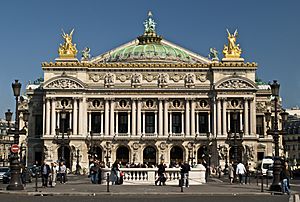
For most of the war, Poulenc was in Paris. He gave concerts with Bernac, focusing on French songs. Under German rule, he was in a difficult position. But in his music, he showed many acts of defiance against the Germans. He set poems by writers who were part of the French Resistance to music. In Les Animaux modèles, first performed in 1942, he included the tune of an anti-German song. He also helped start a group for music that the Nazis viewed with suspicion. In 1943, he wrote a cantata for choir called Figure humaine. This work, ending with "Liberté" (Freedom), could not be performed in France while the Germans were in control. Its first performance was broadcast from London in 1945. A music critic later wrote that this work "is among the very finest choral works of our time."
In January 1945, Poulenc and Bernac flew from Paris to London. They received a warm welcome. The London Philharmonic Orchestra held a reception for Poulenc. He and Benjamin Britten performed Poulenc's Double Piano Concerto. With Bernac, he gave concerts of French songs and piano works. They also recorded for the BBC. Bernac was deeply moved by the audience's reaction. After their two-week stay, they returned home on the first train from London to Paris since 1940.
Shortly after the war, Poulenc had a daughter, Marie-Ange, in 1946. He provided for her generously, and she was the main beneficiary of his will.
After the war, Poulenc disagreed with younger composers. They rejected Stravinsky's recent work and believed only the new twelve-tone system was valid. Poulenc defended Stravinsky. He found it hard to believe that "in 1945 we are speaking as if the aesthetic of twelve tones is the only possible salvation for contemporary music." This led him to focus on his more serious works. He tried to convince the French public to listen to them. In the US and Britain, his religious music was often performed. But in France, performances were much rarer.
In 1948, Poulenc made his first trip to the US. He went on a two-month concert tour with Bernac. He returned often until 1961. He gave concerts and was the soloist for the first performance of his Piano Concerto (1949).
Later Years and Major Works (1950–1963)
Poulenc started the 1950s by writing new music. He composed a seven-song cycle and the Stabat Mater. This piece was written in memory of a painter friend. It was composed in 1950 and first performed the next year.
In 1953, Poulenc was asked to write a ballet. He decided to write an opera on a religious theme instead. He chose Dialogues des Carmélites, a story about nuns who were guillotined (executed) during the French Revolution for their religious beliefs. Poulenc found it "such a moving and noble work." He began composing in August 1953.
While writing the opera, Poulenc faced difficulties. He learned about a legal dispute over the story's rights, which made him stop working. Around the same time, a close friend became very ill. This stress caused Poulenc to have a nervous breakdown. He was in a clinic in 1954. When he recovered, and the legal issues were resolved, he continued working on Dialogues des Carmélites. He also toured extensively with Bernac in England. His personal wealth had decreased, so he needed the income from his concerts.
Poulenc composed little else while working on the opera. As he finished the last pages of his opera in October 1955, his friend passed away. The composer wrote that his friend was "delivered from his martyrdom" at the very moment he finished the opera.
The opera was first performed in January 1957 in Italy. Before its French premiere, Poulenc introduced one of his most popular later works, the Flute Sonata. He performed it with Jean-Pierre Rampal in June. Three days later, on June 21, the Paris premiere of Dialogues des Carmélites took place. It was a huge success, which greatly relieved the composer.
In 1958, Poulenc worked with his old friend Cocteau on an opera version of Cocteau's play La Voix humaine. This work was performed in 1959. It featured Duval as a sad woman talking to her former lover on the phone. In May, Poulenc's 60th birthday was celebrated with his last concert with Bernac, who then retired.
Poulenc visited the US in 1960 and 1961. During these trips, his works were performed. These included the American premiere of La Voix humaine and the first performance of his Gloria. This was a large work for singer, choir, and orchestra. In 1961, Poulenc published a book about another composer, Chabrier. He wrote about Chabrier with love and understanding.
The works from Poulenc's last year included Sept répons des ténèbres for voices and orchestra, the Clarinet Sonata, and the Oboe Sonata.
On January 30, 1963, Poulenc died from a heart attack in his apartment in Paris. His funeral was held at a nearby church. As he wished, none of his own music was played. Instead, works by Bach were performed. Poulenc was buried in Père Lachaise Cemetery with his family.
Poulenc's Music Style
Poulenc's music is mostly diatonic. This means it uses notes from a standard scale, making it sound clear and often cheerful. The most important part of his music was his ability to create beautiful melodies. A music scholar noted that Poulenc found "a vast treasury of undiscovered tunes." His melodies are simple, pleasing, and easy to remember. They often express strong emotions.
Poulenc said he wasn't very inventive with his harmonies (how notes sound together). But his use of common harmonies was so unique that his music always sounded fresh and valid. His harmonies were clear and simple. Poulenc didn't like strict musical theories. He believed in composing from feeling, not rules. He also disliked composers who followed the twelve-tone system too strictly. He felt that almost all his music was inspired by the human voice. Poulenc was a careful craftsman. He worked hard on his music, even though some people thought it came easily to him. He said, "The myth is excusable, since I do everything to conceal my efforts."
A pianist named Pascal Rogé said in 1999 that both sides of Poulenc's music were important. You have to accept both his serious and light-hearted works to truly understand him. Poulenc himself wanted his music to be "healthy, clear and robust – music as frankly French as Stravinsky's is Slav."
Music for Orchestra and Solo Instruments
Poulenc wrote several important works for large orchestra. These include two ballets, a Sinfonietta, and four concertos (pieces for a solo instrument with orchestra).
His first ballet, Les biches (1924), is still one of his most famous. It has clear and tuneful music. The first two concertos are light-hearted. The Concert champêtre for harpsichord and orchestra (1927–28) sounds like the countryside from a Parisian view. The Concerto for two pianos and orchestra (1932) is meant to be entertaining. It uses different styles, including sounds like Balinese gamelan music and Mozart.
The Organ Concerto (1938) is much more serious. Poulenc said it was "on the outskirts" of his religious music. It has parts that sound like church music by Bach, but also some lively, popular sections.
His second ballet, Les Animaux modèles (1941), is not as popular as Les biches. But other composers praised its harmonies and orchestration. The Sinfonietta (1947) is a return to Poulenc's light-hearted style. The Concerto for piano and orchestra (1949) was initially disappointing to some. But in recent years, it has been seen as one of his best concertos.
Piano Music
Poulenc was a very skilled pianist. He usually composed at the piano and wrote many pieces for it throughout his life. Most of his piano works are short pieces, like "miniatures." Poulenc himself was critical of some of his piano music. He liked his Mouvements perpétuels, his Suite en ut, and his Trois pieces. He also liked his two collections of Improvisations, an Intermezzo, and some Nocturnes. He didn't like Napoli and the Soirées de Nazelles as much.
The fifteen Improvisations were written between 1932 and 1959. They are all short, varying from fast and ballet-like to gentle and lyrical. They include marches, waltzes, and a musical picture of the singer Édith Piaf. The Intermezzo in A flat is described as "charming" and "unmistakable Frenchness." The eight nocturnes were composed over nearly a decade. They are "night-scenes and sound-images" rather than romantic pieces.
The pieces Poulenc found "tolerable" were all early works. Trois mouvements perpétuels is from 1919. Napoli (1925) is a three-part musical portrait of Italy. Les Soirées de Nazelles is like character sketches of his friends. Even though Poulenc didn't like it, some critics found it clever and witty. Other well-known piano pieces include the two Novelettes (1927–28) and Villageoises (1933) for children.
Chamber Music
Poulenc's chamber works (music for small groups of instruments) fall into three periods. The first four sonatas are early works, written before he was twenty-two. They are for two clarinets (1918), piano duo (1918), clarinet and bassoon (1922), and horn, trumpet, and trombone (1922). They are short, playful, and witty. Other early chamber works include the Rapsodie nègre (1917) and the Trio for oboe, bassoon and piano (1926).
The chamber works from Poulenc's middle period were written in the 1930s and 1940s. The most famous is the Sextet for Piano and Wind (1932). It is light-hearted, with two lively movements and a central playful section. Poulenc revised this work later. The sonatas in this group are for violin and piano (1942–43) and for cello and piano (1948). Writing for string instruments was harder for Poulenc. These sonatas are mostly serious.
The final three sonatas are for woodwind instruments and piano: for flute (1956–57), clarinet (1962), and oboe (1962). These pieces are now very popular because of their skill and beauty. The Élégie for horn and piano (1957) was written in memory of a horn player. It even uses a brief twelve-note pattern, which was rare for Poulenc.
Songs
Poulenc wrote songs throughout his career, and he wrote many of them. Most of his best songs were written in the 1930s and 1940s. He often chose poems by Guillaume Apollinaire and Paul Éluard. Other poets he frequently set to music included Jean Cocteau and Max Jacob. Many of his Éluard songs are considered his greatest. The song cycle Tel Jour, Telle Nuit (1937) is seen as a masterpiece. These songs show a depth of feeling far from his early, more playful music. One of his songs, "C" (1943), is described as "a masterpiece known the world over" about the pain of war.
A music scholar said that Poulenc's melodies fit the text so well that they seem to complete it. He was very skilled at highlighting the meaning of the words. Among his lighter pieces, one of his most popular is Les Chemins de l'amour, a Parisian waltz. In contrast, his "monologue" "La Dame de Monte Carlo" (1961) shows his understanding of sadness.
Choral Music
Poulenc started writing choral music (for choirs) in 1936. In that year, he wrote three choral works. These included Sept chansons and his religious work Litanies à la Vierge Noire. The Mass in G major (1937) for choir without instruments has a lively, joyful style. Poulenc's new religious theme continued with Quatre motets pour un temps de pénitence (1938–39).
One of his most important choral works is the cantata Figure humaine (1943). Like the Mass, it is for unaccompanied choir and needs very skilled singers. Other works for choir without instruments include the Quatre motets pour le temps de Noël (1952).
Poulenc's major works for choir and orchestra are the Stabat Mater (1950), the Gloria (1959–60), and Sept répons des ténèbres (1961–62). All these works are based on religious texts. In the Gloria, Poulenc's faith is expressed in a joyful way, with moments of calm and mystic feeling. Poulenc wrote to Bernac in 1962, "I think I have three good religious works. May they spare me a few days in Purgatory, if I narrowly avoid going to hell." Sept répons des ténèbres, which Poulenc never heard performed, uses a large orchestra. It is considered one of his most emotionally demanding and musically interesting sacred pieces.
Operas
Poulenc only started writing operas later in his career. He was in his forties before he wrote his first opera. He felt he needed to be mature enough to handle the subjects he chose. He said that a young composer couldn't write The Carmelites because the problems were too deep. All three of Poulenc's operas show deep feeling. Les Mamelles de Tirésias (1947), despite its wild plot, is full of nostalgia. In his two serious operas, Dialogues des Carmélites (1957) and La Voix humaine (1959), Poulenc shows deep human suffering.
Musically, the operas show how much Poulenc had grown. In Les mamelles de Tirésias, he uses lyrical solos, duets, and chorales. It manages to be both funny and beautiful. In all three operas, Poulenc used ideas from earlier composers. But he blended them into music that was clearly his own. Dialogues des Carmélites is one of the few operas written since World War II that is performed all over the world.
Even when writing for a large orchestra, Poulenc used the instruments carefully in his operas. He often wrote for woodwinds, brass, or strings alone. With help from Bernac, he became very skilled at writing for the human voice. He made the music fit each character's singing range. In his last opera, La Voix humaine, Poulenc even gave the singer parts with no orchestra at all.
Recordings
Poulenc was one of the composers who realized early on how important the gramophone (record player) would be. The first recording of his music was made in 1928. He played the piano for the singer Claire Croiza in his song cycle La bestiaire. He made many recordings, mostly for EMI. With Bernac and Duval, he recorded many of his own songs. He also recorded songs by other composers like Debussy and Ravel. He played the piano in recordings of his Babar the Elephant with different narrators. In 2005, EMI released a DVD called "Francis Poulenc & Friends." It showed filmed performances of Poulenc's music, played by him and other famous musicians.
A list of Poulenc's music recordings from 1984 includes over 1,300 conductors, soloists, and groups. These include famous names like Leonard Bernstein and Yehudi Menuhin.
Complete sets of Poulenc's solo piano music have been recorded by several pianists. These include Gabriel Tacchino, who was Poulenc's only piano student, and Pascal Rogé. Complete sets of his chamber music have also been recorded.
The first performance of Dialogues des Carmélites was recorded and is available on CD. Since then, there have been at least ten more recordings of the opera.
Poulenc's Legacy
Poulenc's two different musical sides often caused misunderstandings. Some critics still underestimate his serious works. His focus on melody, in both his light and serious pieces, also led some to see him as not modern enough. However, Poulenc was always interested in the music of younger composers.
In his later years, Poulenc said, "if people are still interested in my music in 50 years' time it will be for my Stabat Mater rather than the Mouvements perpétuels." But a critic noted in 1999 that Poulenc was wrong. He is now celebrated for both sides of his musical character. This includes his religious works like the Gloria and his ballets like Les Biches. Another writer described Poulenc as "a fizzing, bubbling mass of Gallic energy who can move you to both laughter and tears within seconds." His music speaks clearly and directly to all generations.
See also
 In Spanish: Francis Poulenc para niños
In Spanish: Francis Poulenc para niños


